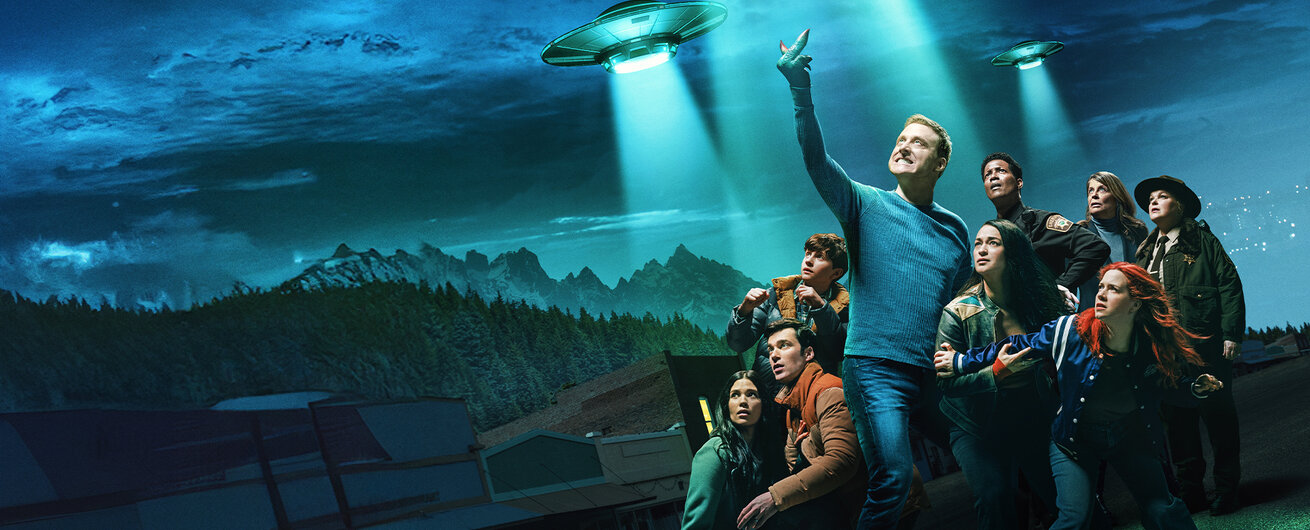Create a free profile to get unlimited access to exclusive videos, sweepstakes, and more!
JWST Finds Possible Signs of Life on Exoplanet K2-18 b
JWST smells something "fishy" on nearby exoplanet.
SYFY's Resident Alien (streaming now on Peacock) presents a common sci-fi fantasy in which an intelligent alien — usually one which looks surprisingly humanoid and devilishly handsome — drops onto our proverbial doorstep and settles the question of whether we’re alone in the universe all at once. Our experience in the real world hasn’t been quite as dramatic.
Instead, scientists all over the world are turning over every cosmic rock we can find, looking for signs of life elsewhere in the cosmos. And the James Webb Space Telescope (JWST) is one the newest and best tools at our disposal. Now, astronomers may have detected tentative evidence of life on a potentially habitable world, according to a new study accepted to The Astrophysical Journal Letters.
JWST’s Mission to Characterize Alien Atmospheres
Mostly, what gets JWST into the headlines are its spectacular views of distant cosmic locales. It was purpose built to operate at incredibly cold temperatures way out at the L2 Lagrange point specifically so that it could peer farther into space and see in greater detail than ever before. You’ve seen the results in beefed up images of our favorite celestial haunts and never-before-seen shots of some of the most remote places in the universe. But that’s not all JWST has going for it.
RELATED: NASA is Thinking of New Ways to Find Aliens… If They Exist
The telescope is also equipped with onboard instruments including the Near-Infrared Imager and Slitless Spectrograph (NIRISS) and the Near-Infrared Spectrograph (NIRSpec) which provide insight into what the telescope is seeing.
Spectrometers work by taking in light and splitting it into wavelengths, not unlike sunlight through a prism. Then they measure the intensity of light at different wavelengths along the electromagnetic spectrum. Basically, JWST looks at distant stars, planets, and galaxies, and teases out details in the light coming off of them. That might not sound very exciting, but it can tell us a lot about what we’re seeing.
The colors we experience as we walk through the world are the brain’s way of interpreting different wavelengths of light. You may not know the precise wavelength of the light you’re seeing, but your brain does, and it interprets it into color on your behalf. A similar relationship occurs when matter comes into contact with an energy source. As the atoms are excited in the presence of energy, they give off light (not always visible) and the characteristics of that light are like a fingerprint.
It’s the principle behind glow lamps, commonly called neon lights. You put some gases or other materials inside, and you introduce energy. Then the gas vaporizes, becomes plasma, and glows. The color of the light you get depends entirely on the materials you put inside. If you know the light signature that different materials leave behind, then you can tell what something is made of even if it’s light-years away.
Exoplanet K2-18 b Looks Habitable and Maybe Even Occupied
Astronomers pointed JWST at a relatively nearby planet called K2-18 b. It orbits inside the habitable zone of a dwarf star about 120 light-years away, in approximately the direction of Leo. We’ve looked at it before, with the Hubble Space Telescope, but new observations with JWST suggest it may be a Hycean (a mashup of hydrogen and ocean) world with liquid water oceans and a hydrogen-rich atmosphere.
They’ve been proposed and are thought to be common around red dwarfs (the most common type of star in the galaxy), making them a potential location for extraterrestrial life. However, we had never confirmed the existence of one until now.
Spectral data from K2-18 b revealed the presence of methane and carbon dioxide in the atmosphere and suggests the presence of a water ocean beneath a hydrogen-rich atmosphere. “Our findings underscore the importance of considering diverse habitable environments in the search for life elsewhere. Traditionally, the search for life on exoplanets has focused primarily on smaller rocky planets, but the larger Hycean worlds are significantly more conducive to atmospheric observations,” Nikku Madhusudhan, lead author of the paper, said in a statement.
RELATED: Astrobiologist Suggests We May Have Found and Killed Martian Life 50 Years Ago
The potential confirmation of a Hycean world is exciting enough on its own but that’s not all that NIRISS and NIRSpec picked up. The telescope instruments also made a possible detection of a molecule called dimethyl sulfide (DMS). On Earth, DMS is only produced by living things. Mostly, it is made by phytoplankton in the ocean, but it’s also produced by some bacteria. It’s the most common biological sulfur found in the atmosphere, and it smells funky. You know the “ocean smell” that you pick up anytime you’re at the beach or at the fish market? A large component of that smell is dimethyl sulfide.
As far as we know, if all life on Earth suddenly vanished then so would the DMS. So, finding it on another planet is, at the very least, intriguing. Researchers note that the DMS detection has not been confirmed and will require additional observations. The data so far comes from only two transit observations and more are planned.
"Our ultimate goal is the identification of life on a habitable exoplanet, which would transform our understanding of our place in the universe. Our findings are a promising step towards a deeper understanding of Hycean worlds in this quest,” Madhusudhan said.
While we’re waiting for JWST to confirm smelly space fish on K2-18 b, catch up on Resident Alien, streaming now on Peacock.




































